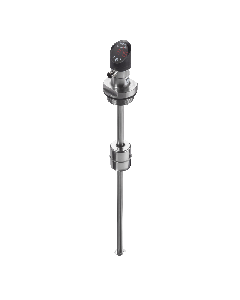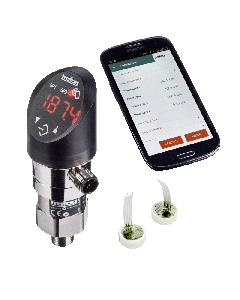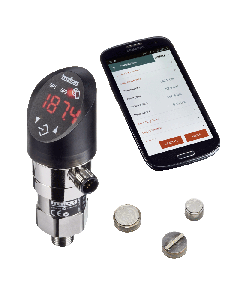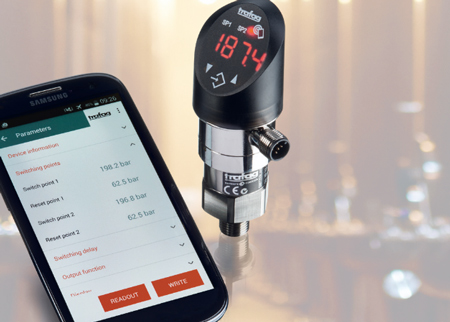More efficiency by linking display pressure switches and smartphones together
Smartphone-enabled display pressure switches simplify both the commissioning process and the handling of spare parts.
Electronic pressure switches with display (display pressure switches)have existed for many years and are now available in a variety of versions. Considered in terms of the product life cycle, these products are now in the third stage of development: During the initial phase, new features and designs were the main focus, while cost-cutting measures marked the second phase. In the current third phase, the devices are equipped with additional connectivity (communication possibilities) and, in part, with their own intelligence. In addition to general technological developments, this development is mainly driven by the megatrends of the IoT (Internet of Things) and Industry 4.0, for a consistent networking of machine sensors to the ERP (Enterprise Resource Planning) system with the aim of «self-organized production.»
While many companies are concentrating on the connectivity of sensors and controls, mainly through the integration of communication interfaces and protocols, Trafag took a different route: the connection from the sensor to the human being. Trafag consistently pursued the mobile-first approach and placed the focus for the parameterization of the display pressure switch on the smartphone app. In contrast to the integrated 3-button operation with a 4-digit 7-segment display according to VDMA 24574-1, via the smartphone app one can navigate via the graphical user interface very quickly and intuitively through the parameterization. An integrated, configurable logger records the measured data, which can then also be sent via the app to the smartphone. In the industrial environment, these advantages of direct connection between humans and sensors over a smartphone can be used to increase efficiency and quality.
Parameterization during testing and commissioning
Who doesn’t know that? The switch points and their parameters are defined by engineering, but during commissioning, it becomes clear that optimizations are still necessary, which are often determined in several loops. If the entire system can communicate via a bus system or IO-Link, this can be solved by the central controller. However, in spite of the great attention that these subjects are enjoying today, in reality most controllers on the sensor level communicate with conventional analog as well as digital signals and thus have no way of centrally controlling the parameterization of the pressure switches. In such cases man comes to the rescue. This points to a general success factor of the display pressure switches: the user sees the current measured value and further information on the display and can adjust the switching points directly on the spot without interfering with the control. Thanks to the possibilities of a smartphone and the new App from Trafag it is now much easier to adjust the switching points. In addition, different parameter sets can be stored. In the case of test and optimization runs, a previously stored parameter profile can be loaded back to the pressure switch very quickly or sent to other measuring points. Compared to the conventional parameterization via VDMA three-button operations, this of course is much faster and more efficient, and thanks to the copying option, the error rate is significantly lower. Storing the clear-text-readable parameter sets also makes the documentation very simple and transparent.
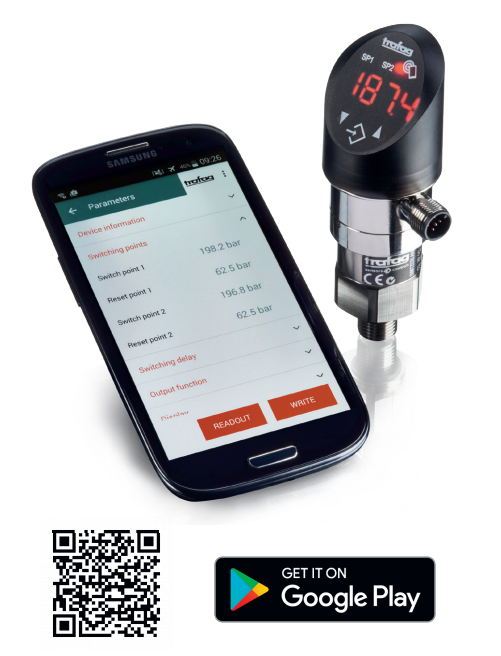

Simplified stock handling
Most machine and system manufacturers use display pressure switches, which, in addition to the switching outputs, also require analog outputs (for example 4 ... 20mA, 0 ... 10VDC) at various measuring points. Depending on the measuring point, the devices might differ only by means of the set switching points and the measuring range and consequently the analog signals. To facilitate the reduction of spare parts for maintenance, the Trafag display pressure switch DPC and DPS is ideal; besides the very simple parameterization by stored parameter sets, the 2:1 turn-down capability also helps to keep the spare parts to a minimum. It is possible to adjust the measuring range down to 50% of the nominal range as desired via the parameter sets, thus scaling the desired analog signal to the individual measuring range.
The parameters can be adapted without power to the instrument! NFC (Near Field Communication), and not Bluetooth or WLAN, acts as the interface. This allows the replacement service or the service personnel to parameterize the instruments out of the box and unpowered. Otherwise it is also possible to check whether the correct parameter set is stored in the device before installation.
Easy reparameterization in the service case
In addition to the above-mentioned advantages, the need for service is also simplified by the direct access of the employee to the device parameters - without intervention in the control system. Thus, as a first error analysis, an employee of the operator can send the set parameters by e-mail to the customer service, which then checks whether the settings are correct. Another feature which is very useful in this case is the integrated logging function of the DPC / DPS, which records the applied trend of pressure and stores it in the device. This measured data can also be transferred via the NFC as a CSV file (Comma-separated Values) to the smartphone. This file may be sent by e-mail and be evaluated, for example by Excel, for system diagnostics.
In addition to system diagnostics, the integrated logger function offers even more interesting applications. For simple experimental setups - whether in the development of prototypes and function patterns, in testing or in laboratory experiments at colleges and universities - can be constructed without any additional equipment for measuring data acquisition: It only requires the connection of the DPC / DPS to a corresponding voltage supply, in order to then readout the measured data via the app. To connect the DPC / DPS display pressure switch to any power socket, Trafag offers a complete kit, available with a matching case and power adapter. Because the acquisition of pressure measurement data can be installed within a few minutes, the acquisition of measured data is also possible in situations where the installation of a conventional measurement data acquisition would not be worthwhile or where it would not be possible for logistical reasons (for example, because the service technician for the diagnosis can arrive with only limited luggage).
Security issue
The downside of easy access to parameterization is, of course, the security issue. Here, however, the choice of NFC, with its close proximity range, offers considerable advantages over the other protocols WLAN or Bluetooth. Protocol that operate with greater proximity, are less secure, it is possible that access is gained from outside the factory, which makes complex encryption technologies necessary. Since NFC has a range of a few millimeters, it doesn›t work without direct access to the devices. The existing access rules are already sufficient to prevent access by outsiders. To ensure that unauthorized persons do not change any parameters, the access to the display pressure switch can be protected by means of a four-digit code, which also prevents NFC access. The presented examples show how the introduction of new technology, by the combining of smartphones and the electronic pressure switches, respectively, introduce new ways for enterprises to easily capture by a simple and efficient means, reducing inventory, bureaucracy and cost, to become more efficient repeatable and competitive.
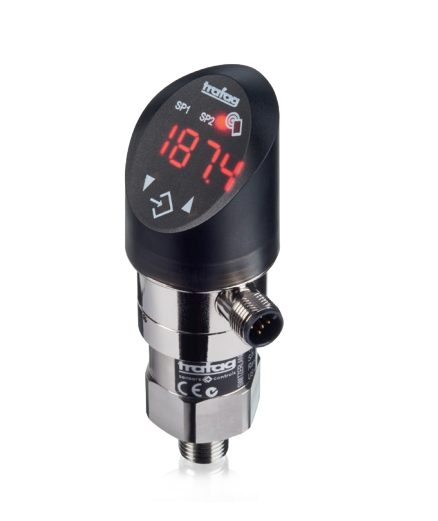

Would you like to read the whitepaper later?
Do you have any questions about linking display pressure switches and smartphones together?
We'd be glad to help. Please get in touch with us.


